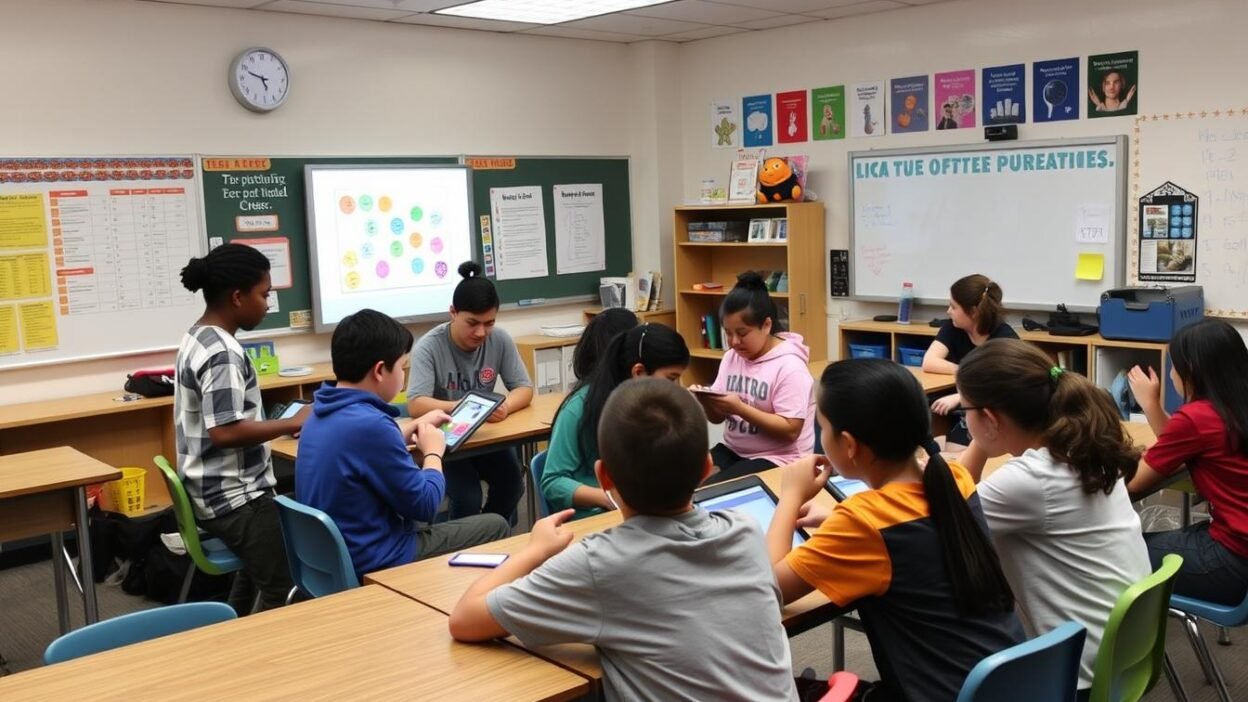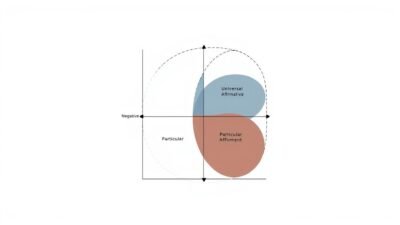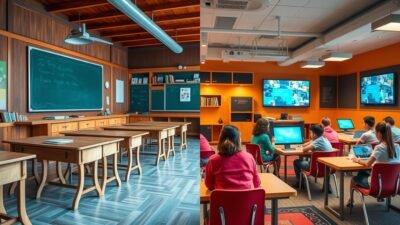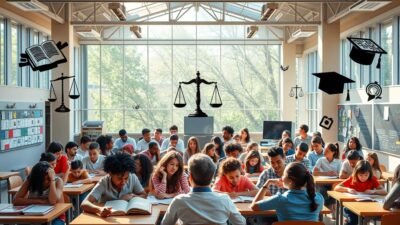Are our traditional teaching methods truly preparing students for the challenges of tomorrow’s world? As we stand at the crossroads of education and technology, this question becomes increasingly crucial. The landscape of higher education is evolving rapidly, demanding a shift from conventional approaches to innovative teaching strategies that engage and inspire modern learners.
In today’s fast-paced digital era, effective pedagogical approaches are essential for nurturing critical thinking and adaptability. Universities worldwide are reimagining their classrooms, integrating cutting-edge tools and methodologies to create dynamic learning environments. This transformation isn’t just about adopting new technologies; it’s about fundamentally rethinking how we facilitate learning and prepare students for an ever-changing global landscape.
As we delve into the realm of innovative teaching methods, we’ll explore how these strategies are reshaping the educational experience. From flipped classrooms to project-based learning, these approaches are designed to foster engagement, promote deep understanding, and equip students with the skills they need to thrive in their future careers.
Preparing for the UGC NET exam can be a daunting task, but with the right resources, candidates can navigate the process effectively. Websites like MyJRF provide a comprehensive platform for aspiring educators, offering specialized guidance for UGC NET Paper 2 preparation and essential tips for acing UGC NET Paper 1. Additionally, understanding the revised syllabus provided by UGC is crucial for a targeted study approach. For official announcements and updates, candidates should regularly visit the UGC NET NTA portal, while the UGC’s job section and the main UGC website are invaluable for post-exam opportunities and academic resources. With these tools, candidates can maximize their preparation and set themselves up for success.
Key Takeaways
- Traditional teaching methods are being replaced by innovative strategies in higher education
- Technology integration is crucial for creating engaging learning environments
- Student-centered approaches promote active learning and critical thinking
- Diverse and inclusive teaching methods enhance learning outcomes for all students
- Continuous evaluation and adaptation of teaching strategies are essential for success
Understanding the Need for Innovative Teaching Strategies
The landscape of higher education is rapidly evolving. Traditional teaching methods are struggling to keep pace with the changing needs of students and the job market. This shift calls for a fresh approach to higher education teaching techniques.
Why Traditional Methods Are No Longer Effective
Lecture-based classes and rote memorization are losing their effectiveness in today’s dynamic learning environment. Students now expect interactive, engaging experiences that prepare them for real-world challenges. Modern learning strategies must address these expectations to ensure student success.
- Lack of student engagement
- Limited practical application
- Inability to cater to diverse learning styles
The Rise of Digital Learning Environments
Digital tools for teaching are transforming the educational landscape. Online platforms, virtual reality, and artificial intelligence are creating new possibilities for immersive learning experiences. These technologies enable educators to deliver content in ways that were previously impossible.
| Traditional Methods | Digital Learning Environments |
|---|---|
| One-size-fits-all approach | Personalized learning paths |
| Limited interaction | Enhanced collaboration |
| Time and location constraints | Flexible access to resources |
As we embrace these new digital tools for teaching, it’s crucial to develop innovative higher education teaching techniques that leverage technology while maintaining the core principles of effective education. The future of learning lies in striking this balance.
Embracing Technology in the Classroom
Modern higher education demands innovative approaches to teaching and learning. Digital tools for teaching have become essential in creating engaging and effective learning environments. Let’s explore how technology transforms the classroom experience.
Tools for Interactive Learning
Interactive learning tools enhance student engagement and promote active participation. Some popular options include:
- Virtual reality simulations
- Online polling and quiz platforms
- Collaborative digital whiteboards
- Interactive video lessons
These digital tools align with online education best practices, allowing students to interact with course material in new and exciting ways. They cater to diverse learning styles and foster a more dynamic classroom atmosphere.
Utilizing Learning Management Systems (LMS)
Learning Management Systems play a crucial role in modern learning strategies. They provide a centralized platform for course materials, assignments, and communication. Key benefits of LMS include:
| Feature | Benefit |
|---|---|
| Content Organization | Easy access to course materials |
| Assignment Submission | Streamlined grading process |
| Discussion Forums | Enhanced peer-to-peer learning |
| Progress Tracking | Personalized learning paths |
By integrating these technological tools, educators can create a more inclusive and effective learning environment. This approach supports diverse learning needs and prepares students for the digital workplace.
Student-Centered Learning Approaches
Education is evolving, and student-centered teaching practices are at the forefront of this change. These approaches put learners in the driver’s seat, fostering deeper understanding and engagement.
Flipped Classroom Model
The flipped classroom turns traditional teaching on its head. Students review lecture materials at home, freeing up class time for active learning techniques. This model allows for more hands-on activities and personalized instruction, making it an effective pedagogical approach.
Project-Based Learning
Project-based learning immerses students in real-world challenges. By tackling complex problems, learners develop critical thinking skills and practical knowledge. This method exemplifies student-centered teaching practices, as it encourages self-directed exploration and creativity.
Promoting Collaborative Learning
Collaborative learning is a cornerstone of modern education. It involves:
- Group discussions
- Peer teaching
- Team projects
These activities enhance communication skills and expose students to diverse perspectives, essential in today’s interconnected world.
“Tell me and I forget, teach me and I may remember, involve me and I learn.” – Benjamin Franklin
By implementing these student-centered approaches, educators can create a dynamic learning environment that prepares students for future challenges. Active learning techniques not only boost engagement but also foster skills crucial for success in the 21st century.
The Importance of Diversity and Inclusion
Diversity and inclusion are key components in Teaching Strategies for Modern Higher Education. These elements create rich learning environments that prepare students for a globalized world.
Strategies for Inclusive Curricula
Effective pedagogical approaches in higher education embrace diverse perspectives. Inclusive curricula integrate various cultural viewpoints, experiences, and histories. This approach enhances learning for all students, regardless of background.
- Incorporate diverse authors and perspectives in course materials
- Use case studies that reflect varied cultural contexts
- Encourage discussions on global issues and viewpoints
Culturally Responsive Teaching
Student-centered teaching practices often include culturally responsive methods. These techniques recognize and value students’ cultural backgrounds, creating a more engaging learning experience.
| Culturally Responsive Strategy | Implementation | Benefits |
|---|---|---|
| Diverse Learning Materials | Use texts from various cultures and perspectives | Broadens student understanding and relatability |
| Inclusive Language | Avoid cultural assumptions in speech and writing | Creates a welcoming environment for all students |
| Cultural Celebrations | Acknowledge diverse holidays and traditions | Fosters cultural appreciation and respect |
By implementing these strategies, educators can create more inclusive and effective learning environments. This approach not only improves academic outcomes but also prepares students for success in a diverse global society.
Assessment Techniques for Modern Learning
Innovative teaching methods in higher education require effective pedagogical approaches to assessment. The landscape of evaluation has evolved, moving beyond traditional exams to embrace modern learning strategies that provide a more comprehensive view of student progress.
Formative vs. Summative Assessment
Formative assessment tracks learning as it happens, offering continuous feedback. This approach aligns with innovative teaching methods by allowing educators to adjust their strategies in real-time. Summative assessment, on the other hand, evaluates learning at the end of a unit or course. Both play crucial roles in modern education:
- Formative: Quizzes, group discussions, exit tickets
- Summative: Final exams, capstone projects, portfolios
Integrating Peer Assessments
Peer assessment is a powerful tool in modern learning strategies. It encourages students to critically evaluate their peers’ work, fostering deeper understanding and collaboration. This method supports effective pedagogical approaches by:
- Developing critical thinking skills
- Enhancing communication abilities
- Promoting self-reflection
By incorporating these diverse assessment techniques, educators can create a rich learning environment that supports student growth and aligns with the demands of modern higher education.
Cultivating Critical Thinking and Problem-Solving Skills
In higher education, fostering critical thinking and problem-solving abilities is crucial. These skills equip students for future challenges and career success. Educators employ active learning techniques to develop these competencies.
Encouraging Inquiry-Based Learning
Inquiry-based learning is a student-centered teaching practice that sparks curiosity and promotes deep understanding. This approach encourages students to ask questions, investigate topics, and draw conclusions. Teachers guide learners through the process, fostering independent thinking and research skills.
- Posing open-ended questions
- Facilitating group discussions
- Providing resources for exploration
- Encouraging reflection on findings
Employing Case Studies and Real-World Scenarios
Case studies and real-world scenarios bridge the gap between theory and practice. These tools expose students to complex situations, requiring them to apply knowledge in practical contexts. This method enhances problem-solving skills and prepares students for workplace challenges.
| Case Study Benefits | Real-World Scenario Advantages |
|---|---|
| Develops analytical skills | Enhances decision-making abilities |
| Promotes teamwork | Improves adaptability |
| Encourages creative solutions | Builds professional confidence |
By integrating these active learning techniques, educators create dynamic learning environments. These student-centered teaching practices nurture critical thinking and problem-solving skills essential for success in today’s rapidly changing world.
The Role of Faculty Development
Faculty development plays a crucial role in implementing innovative teaching strategies for modern higher education. As the landscape of education evolves, educators must adapt their techniques to meet the changing needs of students.
Ongoing Training Programs
Higher education teaching techniques require continuous refinement. Institutions offer ongoing training programs to keep faculty up-to-date with the latest pedagogical approaches. These programs focus on:
- Integrating technology in classrooms
- Developing student-centered learning methods
- Enhancing assessment strategies
- Promoting diversity and inclusion in curricula
By participating in these programs, educators can improve their teaching effectiveness and stay current with innovative teaching methods.
Mentorship Opportunities for Educators
Mentorship is a valuable tool for faculty development. Experienced professors guide newer educators, sharing insights on teaching strategies for modern higher education. This collaboration fosters growth and helps create a supportive academic community.
“Mentorship in higher education is like a bridge connecting experience with innovation, allowing knowledge to flow both ways.”
Through mentorship, educators can:
- Exchange ideas on effective teaching practices
- Receive feedback on their teaching methods
- Learn to navigate challenges in the classroom
- Explore new approaches to student engagement
By investing in faculty development, institutions ensure that their educators are equipped with the skills and knowledge needed to excel in modern higher education environments.
Engaging Students Beyond the Classroom
Education extends far beyond the walls of a lecture hall. Modern student-centered teaching practices recognize the value of engaging learners in real-world experiences. This approach fosters personal growth and practical skill development.
Co-Curricular Activities
Co-curricular activities play a crucial role in enhancing the educational journey. These programs complement academic learning and provide students with opportunities to explore their interests outside of formal coursework.
- Student clubs and organizations
- Academic competitions
- Leadership development programs
- Cultural events and workshops
By participating in these activities, students develop soft skills like teamwork, communication, and time management. These experiences often prove invaluable in their future careers.
Service Learning and Community Engagement
Service learning integrates meaningful community service with instruction and reflection. This effective pedagogical approach allows students to apply classroom knowledge to address real-world challenges.
Service learning bridges the gap between theory and practice, fostering civic responsibility and personal growth.
Community engagement projects offer numerous benefits:
| Benefit | Description |
|---|---|
| Practical Experience | Students apply academic concepts to solve real problems |
| Social Awareness | Exposure to diverse communities broadens perspectives |
| Networking | Interactions with professionals create career opportunities |
| Personal Growth | Challenges push students out of their comfort zones |
By implementing these active learning techniques, educators create a holistic learning environment that prepares students for life beyond graduation. The combination of academic rigor and real-world engagement forms the cornerstone of modern, effective pedagogical approaches.
Measuring Success: Evaluating Teaching Strategies
In the ever-evolving landscape of higher education, it’s crucial to assess the impact of innovative teaching strategies. Effective pedagogical approaches in modern higher education require continuous evaluation to ensure they meet student needs and learning goals.
Metrics for Assessing Effectiveness
To gauge the success of teaching strategies for modern higher education, institutions use various metrics. These include student performance data, engagement levels, and skill development assessments. By analyzing these indicators, educators can refine their methods and improve learning outcomes.
Gathering Student Feedback and Insights
Student input is invaluable when evaluating modern learning strategies. Regular surveys, focus groups, and open discussions provide direct insights into the effectiveness of new teaching approaches. This feedback helps educators adapt their methods to better suit student preferences and learning styles.
By combining quantitative metrics with qualitative student feedback, institutions can create a comprehensive picture of their teaching strategies’ effectiveness. This data-driven approach ensures that higher education continues to evolve, providing students with the best possible learning experience in today’s dynamic educational landscape.
FAQ
What are some innovative teaching strategies for modern higher education?
Innovative teaching strategies for modern higher education include the flipped classroom model, project-based learning, collaborative learning, integrating digital tools for interactive learning, utilizing Learning Management Systems (LMS), implementing student-centered approaches, and employing inquiry-based learning techniques. These strategies aim to enhance student engagement, promote critical thinking, and improve overall learning outcomes.
Why are traditional teaching methods becoming less effective in higher education?
Traditional teaching methods are becoming less effective due to the changing landscape of education and student expectations. The rise of digital learning environments, the need for more interactive and engaging content, and the demand for practical, real-world skills have made passive lecture-based approaches less suitable for modern learners. Additionally, the diverse learning styles and backgrounds of today’s students require more flexible and inclusive teaching strategies.
How can technology be effectively integrated into higher education classrooms?
Technology can be effectively integrated into higher education classrooms through various means:
1. Implementing interactive learning tools such as online polling and discussion platforms
2. Utilizing Learning Management Systems (LMS) for course material distribution and assignment submissions
3. Incorporating multimedia content like videos and interactive presentations
4. Using virtual reality or augmented reality for immersive learning experiences
5. Implementing online collaboration tools for group projects and peer learning
6. Leveraging data analytics to track student progress and personalize learning experiences
What is the flipped classroom model, and how does it benefit students?
The flipped classroom model is an instructional strategy where students review lecture materials and theoretical content outside of class, typically through online videos or readings. Class time is then used for active learning activities, discussions, problem-solving, and applying concepts under the guidance of the instructor. This approach benefits students by:
1. Allowing them to learn at their own pace
2. Providing more time for in-depth discussions and hands-on activities
3. Encouraging active participation and engagement
4. Promoting better understanding and retention of material
5. Developing critical thinking and problem-solving skills
How can educators promote diversity and inclusion in their teaching practices?
Educators can promote diversity and inclusion in their teaching practices by:
1. Developing inclusive curricula that represent diverse perspectives and experiences
2. Implementing culturally responsive teaching methods
3. Creating a safe and respectful classroom environment for all students
4. Using diverse examples and case studies in course materials
5. Encouraging open dialogue and respectful discussions on diversity-related topics
6. Providing accommodations for students with different learning needs
7. Regularly assessing and improving their own cultural competence and biases
What are effective assessment techniques for modern learning environments?
Effective assessment techniques for modern learning environments include:
1. Formative assessments throughout the learning process to provide ongoing feedback
2. Summative assessments to evaluate overall learning outcomes
3. Peer assessments to encourage collaborative learning and critical evaluation skills
4. Project-based assessments that reflect real-world applications of knowledge
5. E-portfolios to showcase student work and progress over time
6. Adaptive assessments that adjust difficulty based on student performance
7. Self-assessments to promote metacognition and self-reflection
How can faculty members stay updated with the latest teaching strategies and technologies?
Faculty members can stay updated with the latest teaching strategies and technologies through:
1. Participating in ongoing training programs offered by their institution
2. Attending professional development workshops and conferences
3. Engaging in mentorship opportunities with experienced educators
4. Joining professional associations related to their field and educational technology
5. Subscribing to educational journals and online resources
6. Participating in online courses or webinars on innovative teaching methods
7. Collaborating with colleagues to share best practices and experiences
What role do co-curricular activities play in modern higher education?
Co-curricular activities play a crucial role in modern higher education by:
1. Enhancing the overall educational experience of students
2. Providing opportunities for practical skill development 3. Fostering leadership and teamwork abilities
4. Promoting civic engagement and social responsibility
5. Offering platforms for creativity and self-expression 6. Complementing classroom learning with real-world applications
7. Helping students build a well-rounded profile for future career prospects
How can the effectiveness of innovative teaching strategies be measured?
The effectiveness of innovative teaching strategies can be measured through:
1. Analyzing student performance data and learning outcomes
2. Conducting regular student surveys and feedback sessions
3. Comparing retention rates and graduation rates over time
4. Assessing improvements in critical thinking and problem-solving skills 5. Evaluating student engagement levels during class activities
6. Tracking post-graduation success rates and employer feedback
7. Conducting longitudinal studies to assess long-term impact on student learning and career outcomes
What are some challenges in implementing innovative teaching strategies in higher education?
Challenges in implementing innovative teaching strategies in higher education include:
1. Resistance to change from faculty or administration
2. Lack of resources or funding for new technologies and training
3. Time constraints in developing and implementing new teaching methods
4. Technical difficulties and varying levels of technological proficiency
5. Ensuring accessibility for all students, including those with disabilities
6. Balancing innovation with maintaining academic rigor and standards
7. Adapting assessment methods to align with new teaching approaches
8. Overcoming student resistance to unfamiliar learning methods





